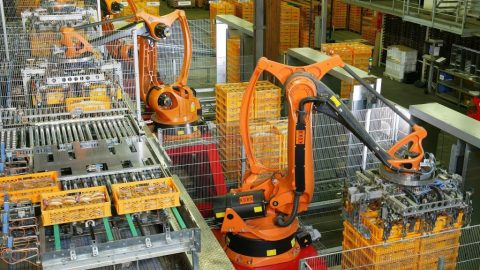
Industrial robots used in a bakery (Source: Wikipedia)
What is industrial automation?
Industrial Automation or Industrial Automation is the use of control systems, for example computers or robots, along with information technology to handle processes and machine operations in manufacturing. Normally, these jobs were still done manually by humans. It is the second step after the mechanization part in the process of industrial modernization.
In the beginning, the goal of automation was to increase productivity (machines can operate 24 hours a day) and cut personnel costs. However, nowadays the emphasis of automation has gradually shifted to increasing quality and adapting to requirements in the production process. For example, in the automotive industry, according to statistics from Ford Group, the process of manually assembling pistons into engines has an average error of 1 to 1.5%, while the assembly process The same automatic current has an error of 0.00001%.
Today, job automation has been widely used, in many manufacturing sectors, especially in industrial countries in North America, Europe or Japan.
In industrial automation systems, Programmable Logic Controller (PLC) is often used. PLCs can be considered as simple computers to assist system builders to create control programs based on logic control algorithms and stimulation events from external systems such as sensors ( sensor) or information recorded at HMI (Human Machine Interface) and MMI (Machine Machine Interface) stations.
For real-time monitoring and control of complex and scattered automated systems at a centralized location, the SCADA (Supervisory Control and Data Acquisition) model is often applied. A SCADA system collects information from the field, from sensors or PLC, then transfers them to the center, notifies the control station of problems that occur, and conduct the analysis and control necessary to handle the problem.
These control technologies are often referred to as production (OT) technologies of manufacturing, and are often referred to as production IT technologies including enterprise-level data processing systems such as ERP, PLM or MES systems.
The main benefits brought from industrial automation include:
In addition to the above benefits, industrial automation is often caught up in a big problem is the high initial investment cost, even very high. Because in addition to investing in machinery and infrastructure, businesses need to invest more in training workers to be able to use these complex systems. In addition, the reduction of production human resources is also a problem related to the social security conditions that industrial automation countries are facing today.
Industrial automation with Industry 4.0
However, with the Fourth Industrial Revolution (Industrial Revolution 4.0), especially the strong and widespread development of Industrial Internet of Thing (IIoT) or Industrial Internet of Things, connectivity Intelligence as well as the peripheral handling ability of the control devices are being promoted rapidly. Automated systems that do not seem feasible or have huge initial investment value are becoming a reality and at a very affordable cost. Automated systems today not only have the ability to react to events, but also have some ability to predict events before they occur.
This intelligent processing capability is increasingly being expanded thanks to the ability to connect and exchange information automatically in real time between devices as well as between IT and OT systems. This also goes with the fact that the boundaries between OT and IT systems are increasingly blurred. IIoT sensors are becoming more affordable with advanced IT technologies such as Cloud / IoT, Big Data Analytic, AI, VR / AR, BlockChain, etc and are starting to replace existing automated systems and rapidly changing tradition of industrial automation.
Facing this new wave, most of the well-known traditional automation companies such as Siemens, GE, Hitachi, Schnieder, etc are also moving their business models to the digitalization model: Siemens has succeeded. announced a strategy to 2020 to develop a strategy based on IoT and Digital Transformation technologies for the industry with expected revenue growth of 7-9%, the highest in the group and above automation (1).
Along with great opportunities, some new challenges are also becoming a significant future threat to the automation industry such as cybersecurity issues, etc. With the development of IoT and enhanced connectivity At high levels, the systems also become more vulnerable. In contrast, with personal computer systems, the consequences of an industrial control system being attacked are serious. According to a Dell statistic, from 2013 to 2014 alone, the number of attacks on SCADA systems doubled (2).
Conclude
With the development of the Internet of Things and Industry 4.0, the industrial automation industry is at a historic turning point. Along with new business opportunities are also new challenges, in which, security and data security issues are and will still be a big problem to be thoroughly responded in the coming time.